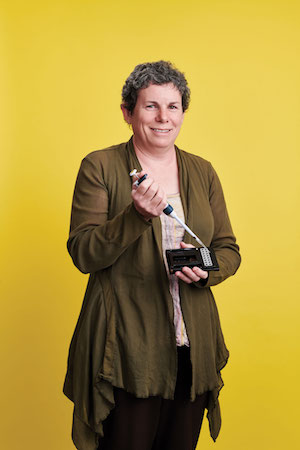FEATURES
Sending Discoveries into the World
Faculty members are transforming research into consumer and clinical uses.
 IMAGE: Adam Simpson
IMAGE: Adam SimpsonA mission to translate research into consumer or clinical settings permeates the Case Western Reserve campus.
"The main motivation is to benefit society by getting ideas into the marketplace where people can actually use them, whether that's a new treatment at the bedside or a safer car or cleaner water for everyone," said Michael Haag (GRS '11, biology), executive director for technology management.
Haag and his colleagues foster innovation by supporting entrepreneurship, negotiating contracts to license university-produced innovations and advocating for an environment in which societal benefit is the ultimate payoff. Consider some results from fiscal year 2018 alone:
- Campus-based startups raised $60 million from investors for university-created technologies.
- The university negotiated 62 licenses and other agreements to help move technology into the public arena.
The university also makes investments with funds from a variety of sources, including the Ohio Third Frontier program. Each year it spends about $2.5 million on promising innovations to help get them ready for commercialization, said Haag, whose staff in the Technology Transfer Office also coordinates the campus activities of programs such as I-Corps@ Ohio, which helps turn inventors into market-savvy entrepreneurs.
Separately, programs such as the Case-Coulter Translational Research Partnership—which promotes collaborations among clinicians and engineers to improve patient care—can help faculty, staff and graduate students cover funding gaps and reduce the risk for others investing in their technology.
When a good idea succeeds, everyone in Case Western Reserve's entrepreneurial ecosystem benefits. For example, proceeds from the sale or initial public offerings of startups created from intellectual property developed by faculty, graduate students and staff, and supported by the CWRU Technology Ventures fund, feed back into that fund, providing continuous support for the university's contribution to Cleveland, Northeast Ohio and the world.
Below are Q&As with some faculty members who are moving along the entrepreneurial path.
Detecting and Treating Cancer
 PHOTO: Roger Mastroianni
PHOTO: Roger MastroianniSusann Brady-Kalnay
Susann Brady-Kalnay, PhD, is a professor of molecular biology and microbiology. She invented SBK2, an imaging solution to detect cancerous tumors. She is in the business discovery phase, identifying possible markets through the state-funded I-Corps@Ohio program.
My motivationMy goal is to help patients by creating better methods to detect and treat cancer.
The pitchToday, a patient has an MRI or other imaging scan and, if a mass is found, a biopsy determines if it's cancerous. I want to inject a solution into the patient before the scan containing an agent that finds tumors and detects if they are malignant immediately, without a biopsy. I also want this agent to light up tumors in the operating room so surgeons can see exactly what needs to be cut out. It can also be used to determine whether cancer therapies are working or not.
My ultimate goal is to have this agent deliver drugs directly to a tumor, reducing side effects and treating cancers that cannot be surgically removed.
Me, an entrepreneur?I've been involved in various entrepreneurship activities and I am drawn to new challenges. My family has 100 acres in Lorain County, Ohio. We started a vineyard a couple years ago. It's mostly grape production, but eventually we'll make wine, too.
 PHOTO: Roger Mastroianni
PHOTO: Roger MastroianniSusann Brady-Kalnay and her team use this rack of tubes to purify the imaging solution they are developing to detect cancer.
What if doctors could tell patients immediately if the mass was cancer or not? What if surgeons could tell you they removed all the cancer? What if you didn't have to open the skull to treat a brain tumor? Think how much better it would be for the patient. That's why I'm pursuing this so rigorously.
Top supportersThe National Institutes of Health awarded me a $3.4 million Academic-Industrial Partnership Award to conduct studies needed for Food and Drug Administration approval. The university has been supportive through its Technology Transfer Office and the Case-Coulter Translational Research Partnership by providing grants for research that will be translated into real-world uses and assisting in patenting the discoveries.
Repairing Brain Cell Damage
 PHOTO: Roger Mastroianni
PHOTO: Roger MastroianniPaul Tesar, left, and Drew Adams
Paul Tesar, PhD (CWR '03), is an associate professor of genetics and genome sciences and the Dr. Donald and Ruth Weber Goodman Professor of Innovative Therapeutics; Drew Adams, PhD, is an assistant professor of genetics and genome sciences and the Thomas F. Peterson Jr. Assistant Professor of Cancer and Energy Research. They are co-founders, members of the board of directors and consultants for Convelo Therapeutics, which is developing drugs to repair brain cell damage caused by neurological disorders, including multiple sclerosis. Founded in 2016, Convelo is working toward clinical trials.
My motivationTesar: When I came back home to Case Western Reserve, one of the leaders in the neuroscience field was Bob Miller [then vice dean for research at the School of Medicine]. He was a pioneer. Having him as a mentor and collaborator is what led me to focus on these brain cells and neurological disorders.
The pitchAdams: We are focused on developing a new class of medicines to stimulate regeneration of the brain and restore function to people with neurological disorders, including multiple sclerosis.
Us, entrepreneurs?Tesar: I've always had a vision: I'll do really great science. It will be clear it has the potential to affect patients and it will move forward. [But] that's actually not the case. Most scientists do not have any experience or training in fundraising and financing. Having an amazing set of advisers really helps build the vision to see this get out into the real world.
What this will accomplishTesar: This potentially changes the game on how we think about treating these diseases. Understanding how the therapy can reduce the severity of symptoms in humans and potentially reverse paralysis is the ultimate goal.
Top supportersAdams: Dean Pamela Davis [MD, PhD] of the School of Medicine [championed] what's called translational science: developing basic science and then taking the first step toward new drugs, devices and cures. Along with Stan Gerson [MD] from the Case Comprehensive Cancer Center, she believed in investing in infrastructure to allow academic discoveries to go forward.
Preserving, Safeguarding Data
 PHOTO: Roger Mastroianni
PHOTO: Roger MastroianniKenneth Singer
Kenneth Singer, PhD, the Ambrose Swasey Professor of Physics is founder, executive chair of the board and chief innovation officer of Folio Photonics Inc., which developed a technique to produce and read data in three dimensions on a single disc, using multilayered polymer films. It was founded in 2012 as a spinoff from the National Science Foundation Center for Layered Polymeric Systems and has agreements pending to partner with data-storage companies. Irina Shiyanovskaya, PhD, an adjunct faculty member at the university, is the chief of technology and operations.
My motivationEarly in my career, I was at AT&T Bell Laboratories, working on projects that bridged basic research and manufacturing. It made me understand how you have to think about manufacturing from the beginning.
The pitchThe exponential growth of digital data production, driven by the internet, media, medicine and other uses, will soon result in over 100 zettabytes of data—1 zb equals 1 billion gigabytes— generated each year. Up to 70 percent of data needs to be archived. As several companies roll out optical archiving systems, Folio Photonics' high-capacity optical discs provide the lowest-cost, longest-lived solution for preserving, safeguarding and optimizing access to the world's data.
Me, an entrepreneur?Starting a company, learning about business, finance—they are all things that I never thought I might do, and sometimes I'm surprised I even thought about doing this. I'm happy I did.
What this will accomplishData needs to be stored long term— doctors need access to the lifetime of your and your family's medical history—and accessed easily, often within seconds. Folio's optical-based DataFilm Disc provides access to decades of data. We're probably three years away from going to market.
Top supportersAll but one of our 60-plus investors are private individuals drawn from my family's network and the board's network. Our institutional investor, Early Stage Partners, provided seed capital and the validation of an institutional investor. The university provided core facilities and equipment that we never could have afforded. We use them often.
Measuring Impact
Startups launched at Case Western Reserve and supported in part by the university provide benefits to the campus and broader community. The following are some of the achievements from the 2018 fiscal year:
- 76 patents granted to faculty, staff and graduate students
- $60 million in venture funding provided for university-based startups
- 10 faculty startups launched
- $3.6 million in revenues collected from licensing and other business agreements





